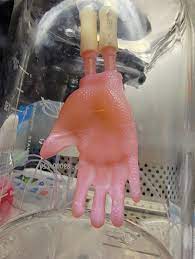Engineered Skin

Engineering skin grafts for complex body parts
“In a new study [from Columbia University], the team tested their skin-culture system using models of human hands and the hindlimbs of mice. . . . . The complex process started with scanning a body part and then 3D printing a biocompatible scaffold in that shape. The scaffolds included ports to allow the infusion of different culture liquids at different stages of skin development. The scaffolds’ structure was designed to support the growth of various types of skin cells in a timed, stepwise fashion that mimics natural skin formation. After about a month of incubating the scaffolds in sequential steps to encourage different layers of cells to grow, the researchers analyzed the engineered skin. . . . When compared with standard, flat cultured grafts, the 3D-cultured skin was more resistant to stresses produced by movement. Further analysis showed that the 3D cultures had higher levels of extracellular matrix proteins, supportive proteins found in mature skin.” MORE
Image Credit: NIH and Columbia University


